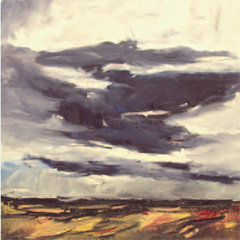
ALTHOUGH CLOUDSPOTTING is an activity best undertaken with time on your hands, it is something that everyone can enjoy. Clouds are the most egalitarian of nature’s displays, since each one of us has a good view of them, so it really doesn’t matter where you are. A little elevation never goes amiss, of course, but this could as easily be provided by a high-rise as by a mountain range of outstanding natural beauty. More important is the frame of mind you are in while cloudspotting. You are not a trainspotter, so standing on a hill with a notebook and pen poised to tick off the different types will end in disappointment. So will any attempt to write down their serial numbers.
A cloudspotter is not a cataloger—meteorologists are busy indexing the different genera, species and varieties of clouds on your behalf. They call it work. Yours is a far more gentle and reflective pursuit—one that will lead to a deeper understanding of the physical, emotional, and spiritual world. John Constable, perhaps Britain’s best cloud painter, saw the sky as “the keynote” and “the chief organ of sentiment” in his landscape paintings. And his cloudscapes do have a drama and vitality to them that I feel is lacking in the rural idylls below.
Constable believed that “we see nothing truly till we understand it.” I agree. If cloudspotters appreciate the way clouds form, what makes them look the way they do, how they shift from one formation to the next, how they grow and develop, how they decay and dissipate, they will have learned more than mere principles of meteorology. Rene Descartes, the French Jesuit philosopher of the seventeenth century, wrote of clouds:
Since one must turn his eyes toward heaven to look at them, we think of them . . . as the throne of God. . . . That makes me hope that if I can explain their nature . . . one will easily believe that it is possible in some manner to find the causes of everything wonderful about Earth.
Stratus is a flat, gray, indistinct sheet of cloud, which is generally featureless in appearance. There are no crisp-looking cauliflower mounds to catch the sunlight on this formation—just an overcast veil that casts a drab, dreary light. Compared with the frenetic and capricious convection clouds, the Stratus is a ponderous individual. It rarely bothers to shed much of its moisture—never managing more than a light drizzle or a gentle snow. It takes its time arriving, and generally outstays its welcome when it does. This is not a cloud known for its spontaneity—it isn’t the type to cause a commotion at picnics with a sudden downpour the moment the sandwiches are out of their foil. When there is a thick layer of Stratus above, people are just more likely to forget the picnic and opt for the cinema instead.
I remember looking up at the same clouds lying on my back in the middle of a busy road. I was seventeen, and had just been knocked off my motorbike. My mother always said the accident happened because family difficulties at home made me take my eye off the road. As I lay on the tarmac, my leg twisted at a horribly inappropriate angle, I looked up at the sky and waited for the ambulance to collect me. Above was a thick, overcast Stratus just like the one today: low, gray, oppressive.
Not long after, my friend’s father, Neville Hodgkinson, told me something that seemed pertinent. He practices the eastern religion of Raja Yoga, as taught by the Brahama Kumaris, an organization established in Hyderabad in 1937. Neville told me that clouds have a symbolic role for some yogis: they stand for the times when the yogis lose track of their spiritual journey. They symbolize the distractions that come between the yogis and the “Supreme Light” of God.
He didn’t say what these distractions were, but given that the Brahama Kumari yogis are teetotaling vegetarians who avoid garlic (which they believe inflames the carnal passions) and practice a strict vow of celibacy, a few possibilities came to mind. Anyway, these distractions occasionally become so profound and sustained that the yogis lose track of their spiritual path altogether. They call it a “storm of Maya.” It is one in which illusory ways of thinking and feeling block out the Supreme Light altogether. At times like these, he said, the yogis remind themselves that, beyond the clouds, the sun never stops shining.
This brought to mind the revelation I had in an airplane as a child: that for the pilot it was, without exception, always a sunny day at work. Not only that, but the view from his office window was one of constantly varied and beautiful cloudscapes. So what about the rest of us, stuck down here, terrestrial in our jobs and distracted in our spiritual paths? On a bleak, gray February morning, it can sometimes be hard not to yearn for the limpidity of direct sunlight.